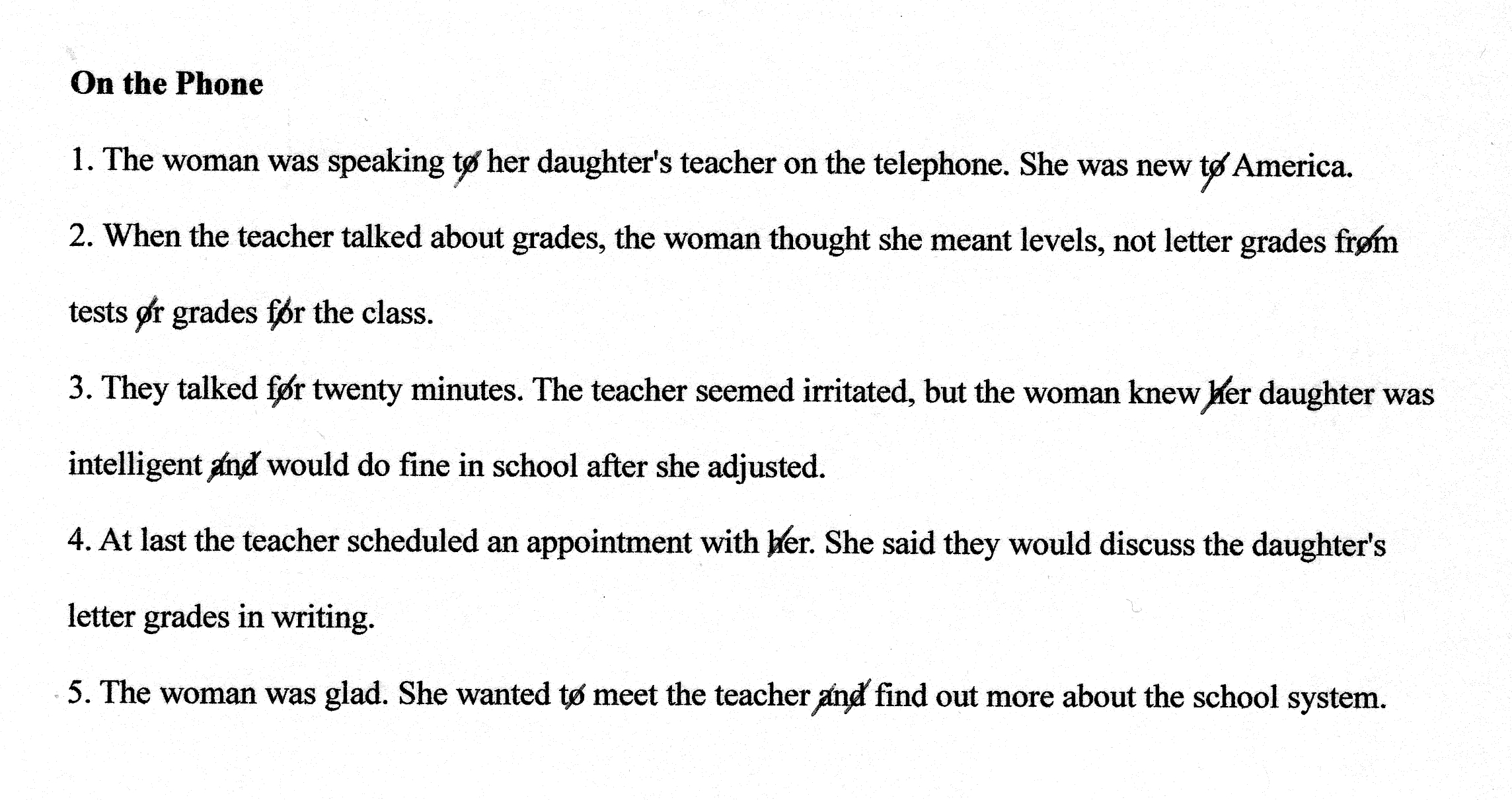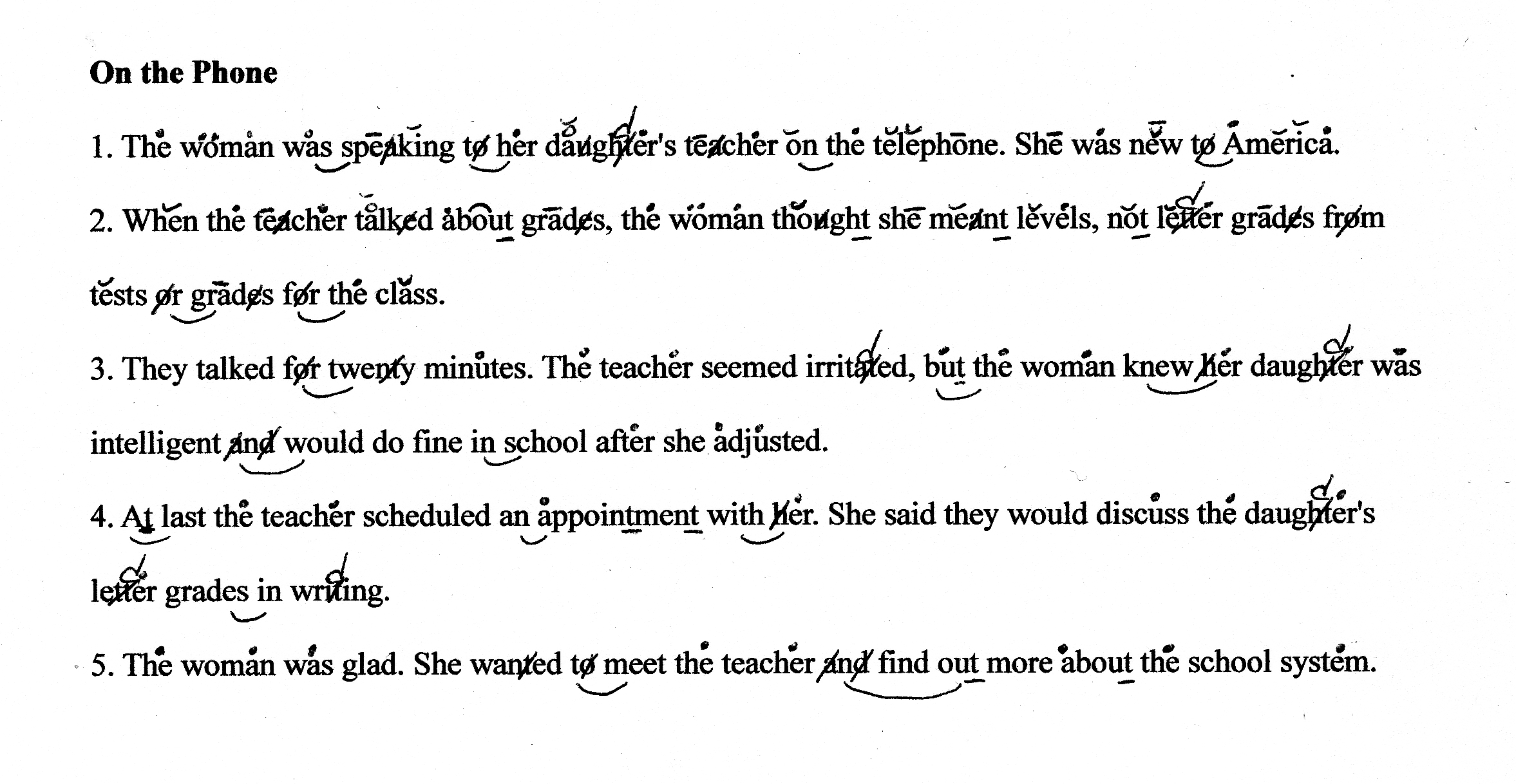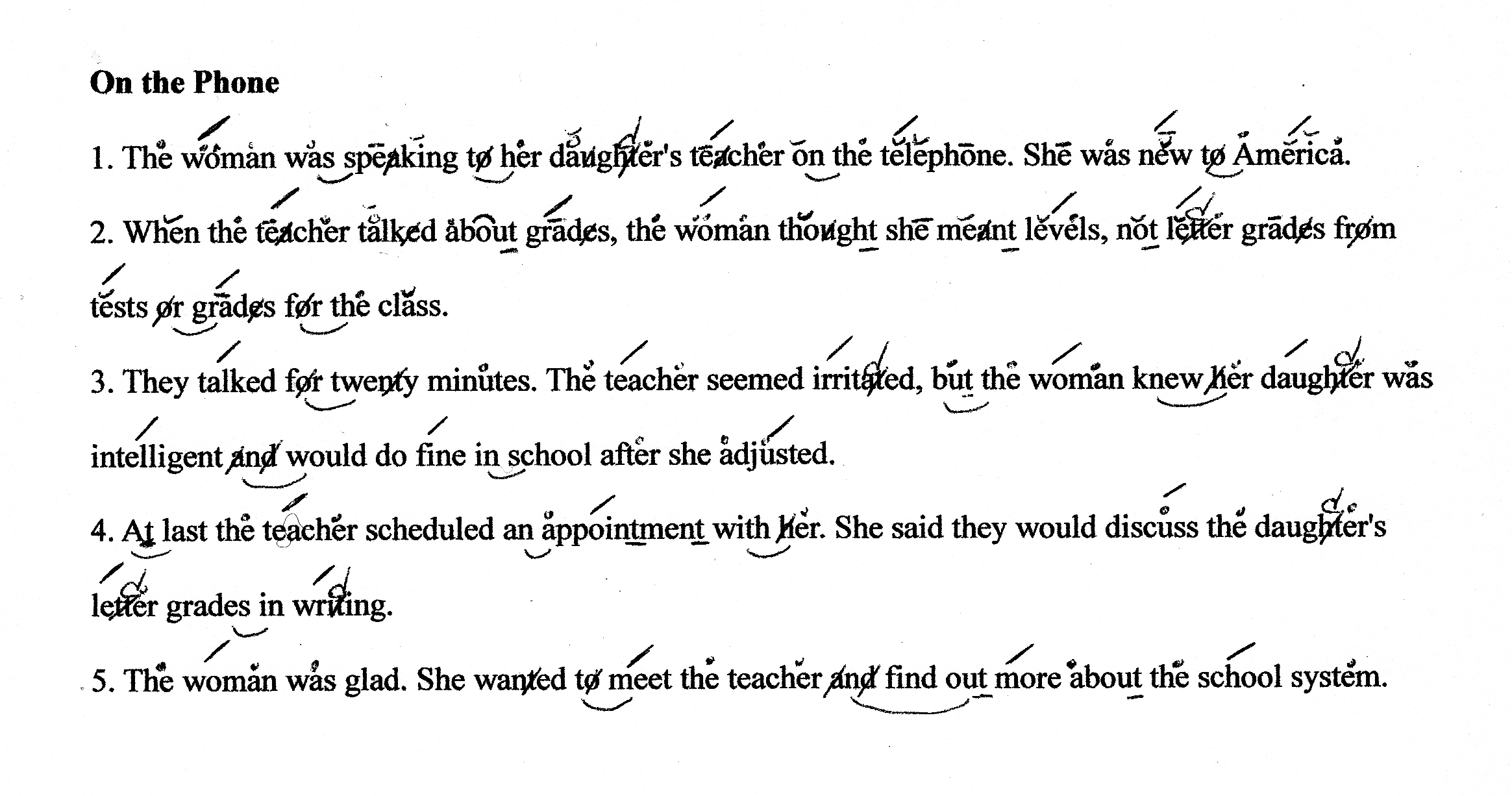with Speak Method
| English Online with Speak Method |
|
| Online Classes | Pronunciation Facts | R, Th, T and other sounds | 500 Words Practice |
| Local Classes | Business Communication | TOEFL Prep | ESL Stories |
| Contact Us | Vowel Sounds |
Grammar and Idioms | For Young People |
Americans like to sound casual, so we barely pronounce certain letters. For instance, we don't pronounce the O in the word “to,” the A and D in the word "and" and generally the vowels in the small words like "for" which is usually pronounced "fr" or "can" which is usually "cn." There are many key examples to this that will give your speech better flow. This step is essential in helping you master rhythm in Step 5. Diagram reduced sounds by crossing out the letters you do not hear, such as O in "to."
Another commonly reduced sound is H in the common
words his,
her, had, has, and have. We often drop the H when the meaning is clear,
such as
when pointing to a man and saying, "What's 'is name?" Or, we may not
say H in the repeated use of the word "his" and "her" in a
story about a man or woman. Perhaps we will say the H about half the
time. In
the answer key, the crossed out H's may differ from the ones you chose.
That is
fine. Only make sure that you do not omit the H in words other than
those
listed above, and make your choices based on expressing meaning clearly.
To read these sounds, attach the reduced word to
the one
that follows. For instance, read "new to America" as "new
t'America." With reduced H's attached the word to one that proceeds as
you
read, such as reading "with her" as "with'er."
Here is a list of common words and how to diagram
them:
can of water and or for his have
to of other from her has had
* If "of" comes before a vowel, the F sounds like
a V. If "of" comes before a consonant, you can cross out the F.
Putting Into Practice
As we go through the rules of the 5 Step Method,
we will
diagram the passage below step by step. Try doing it yourself and then
see how
you did in the answer key that immediately follows. Step One: mark
reduced
sounds. There are not too many.
1. The woman was speaking to her daughter's
teacher on the
telephone. She was new to America.
2. When the teacher talked about grades, the woman thought she meant levels, not letter grades from
tests or grades for the class.
3. They talked for twenty minutes. The teacher seemed irritated, but the woman knew her daughter was
intelligent and would do fine in school after she
adjusted.
4. At last the teacher scheduled an appointment with her. She said they would discuss the daughter's
letter grades in writing.
5. The woman was glad. She wanted to meet the
teacher and
find out more about the school system.

Americans prefer to stress important information,
as you
will see in Step 5. We also do not stress
unimportant
information. Here are several rules for how you can blend words in a
way that
will sound naturally American:
1. Blend small words together. When you see a preposition next to "a" or "the" say both quickly and don't be afraid to let sounds flow together as if the words are combining to form one big word. For instance, "but the" becomes "but-the" with a very small pause on the T. "On the" becomes "onthe" and "or for the" becomes "'rf'rthe." It is as important to blend and reduce sounds as it is to stress them. Also blend common phrases like “once a week.” If the phrase is very common, think of it as one large word.
2. Use flowing letters, like S to merge words and
create
flow. Say "what's'sname" without breaking the words apart at all. Pay
attention to “is” as this word will frequently blend.
3. Blend "and" and "or" with the word
that follows. These words were reduced in step one. Now blend to the
next word.
Say "Fathers 'nMothers" or "bread 'nbutter" or "more
'rless." You can also blend all three words together, but sometimes
this
may interfere with clear speech.
4. Contractions. Even when contractions are not
written,
blend the words quickly. For instance, do not say “I am” as distinct
words.
Rather, blend them as if they are almost the contraction “I’m.” Between
two
vowels, sometimes we hear a small “y” or “w” sound. Do not be afraid to
use
this to blend two common words. You can say “Iyam” or “Weyare” for “we
are.”
*Note: always blend “a” and “the” to the word that
follows.
These are not diagrammed because they are tied to almost every noun.
Diagram Blended sounds by drawing a u-curve
between the
sounds that should blend. Let's add this to our text, On the Phone.
If you want to look at the text first, go to the
original version.
Answers:
Step 3: T-Sounds and others. The American T
is very
different from the British T and actually has 5 different
pronunciations in
American English. Other troublesome consonants are L, R, S, Th, H, V
and W.
Depending on where you are from, some of these will be difficult and
others
easy. In Step 3, we mark all T-sound changes (see below). Only the
T-sound changes
are diagrammed here, but if you struggle with other sounds, such as L
or R, be sure to underline any personal "trouble spots" during this
step.
Letter T: Rule 1
T becomes a D when between two vowel sounds or
between a
vowel and the letter R or L. This is a very soft and fast D sound. If
you say a hard, strong D, that will not sound correct. Read these words:
water = wader bottle = bodl
letter = leder computer = compuder
Notice that vowel sounds and spellings can be
different.
Reduce T for vowel sounds, i.e. say "dauder" for the word
"daughter."
This can also occur between two words when T is the last letter:
It's hot outside = It's hodoutside.
I don't like it at all. = I don't like idadall.
* Note: when diagramming, we will use the blend symbol from Step 2 with these phrases.
Do not change to a D if the syllable is stressed,
as in the
word "Italian."
Letter T: Rule 2
T becomes a hard N when it comes before an N.
Also, vowels
can be skipped here. Read these words:
written = wri'n gotten = go'n
sentence = se'nce mountain = mou'n
Letter T: Rule 3
T is silent when it comes after N. Read these words:
interview = inerview twenty = tweny
interstate = inerstate
Letter T: Rule 4
T is a "stopped" sound at the end of words. We do
not say a full "T," but stop the sound only. Practice with these:
hot
sit got bat
mat meet write
sight date
Letter T: Rule 5
T is normal when it is the first letter. No change
here.
Why does T change?
The letters T, D and N are made in the same place
in the
mouth. As a culture, Americans over time reduced the T sound. Because
the
tongue is in the same place for these 3 letters, T-reductions naturally
coincide with D and N sounds.
Diagramming: we cross out T and write D
when the T
reduces, we cross out T and write N where the Hard N is used (as in
"mountain"), we cross out silent T's and we underline stopped T's.
Let's try our passage. Once again, if you want to look at it for
yourself first, here's a link to the original.
Answers:
The vowels are a, e, i, o and u. In American
English, each
one has two sounds. Also, because some words come from other languages,
you
will find that some letters can have 3 or even 4 sounds. It is easiest
to learn
the sounds and become confident in hearing them through
diagramming and
listening.
The short u sound, called the schwa in phonetics, is also important because it is the simplest sound in the language. It looks like an upside-down small e: ə. When a sound is reduced from common use, it becomes the schwa. This means that the schwa can appear with many different spellings.
Here is a list of key vowel sounds:
Short
vowels
Long
vowels
Other
vowels
a cat a late æo down, ground
e wet e see ü good
i sit i white
o hot o boat
u
(schwa) up
u
flute
When diagramming, short vowels are noted with a
small u over
the vowel, except the schwa. For the schwa, we will simply put a dot.
Long
vowels have a line over them. If a vowel sound uses a different letter,
as in
the letter "a" when it has the short "o" sound, we will write the
letter and symbol
over it. For the æo
sound, we will use a long upside-down u and for the
ü
sound, we will put a double-dot over the letter, whether it is "u" or
"o". If two
vowels are next to each other and one is silent, cross it out. You do
not need
to cross out a final silent e, as that is so common.
Let's practice with On the
Phone. We will diagram all the
vowels in sentences 1 and 2. In sentences 3, 4 and 5, we will only
diagram the
schwa sounds. Practice speaking these vowels aloud, being careful to
understand the symbols.
Answers:

We have some preferences for where we place the stress on syllables and which words we will likely stress in a sentence. Even if your vowels and consonants are perfect, if your rhythm is unusual, many Americans will struggle to understand you. Rhythm is cultural and never learned systematically. Because Americans did not learn it, we do not know that we are using it and most people do not know why they struggle to understand international speakers. Speaking with American rhythm will polish your accent. A few simple rules are below.
Rule 1: New Information
Stress what is new and important to your meaning. Many other languages are more subtle than American English. We are not striving for music. We care about the message we are sending and how to send it clearly.
Rule 2: Nouns are New Information
If you are not sure what's important, a noun is usually a good call. Nouns, until they become pronouns, represent new information.
Rules 3: Verbs When There are Pronouns
If a sentence has a lot of pronouns, the verb is probably more important. Pronouns represent known information, not new information.
Rule 4: Adjectives and Adverbs
If the reading passage or spoken story is long, what was new information at the beginning becomes repeated information toward the middle and end. Then the adjectives and/or adverbs may become what's new and most important.
*** There is no perfect way to stress
information. It often depends on context and intention. If some of your
stresses are different than what you find in the answer key, that is
fine and
quite normal. If all of your stresses are different every time, then
you need
to review the rules above.
Diagram passages by putting a stress mark
over the
important words. Remember to put the stress mark on the correct
syllable.
Answers:

Back to R, TH, T and Others Try Word Stress in 5 Steps Buy Online Classes Back to Speak Method home |